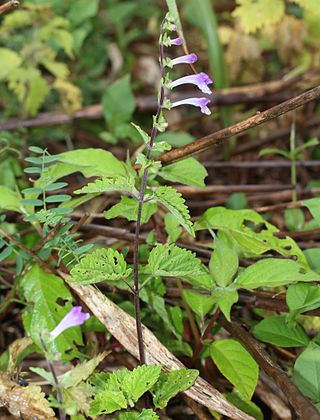
Scutellaria is a genus of flowering plants in the mint family, Lamiaceae. They are known commonly as skullcaps. The generic name is derived from the Latin scutella, meaning "a small dish, tray or platter", or "little dish", referring to the shape of the calyx. The common name alludes to the resemblance of the same structure to "miniature medieval helmets". The genus has a subcosmopolitan distribution, with species occurring nearly worldwide, mainly in temperate regions.

Gynerium is a monotypic genus of Neotropical plants in the grass family, native to Mexico and Colombia, Central America, South America, and the West Indies. It is classified in its own tribe Gynerieae.
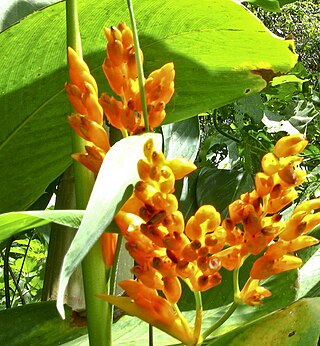
Stromanthe is a genus of flowering plants in the family Marantaceae, native to the tropical portions of the Americas from Mexico to Trinidad to northern Argentina.

Ocimum americanum, known as American basil, lime basil, or hoary basil, is a species of annual herb in the family Lamiaceae. Despite the misleading name, it is native to Africa, the Indian Subcontinent, China, and Southeast Asia. The species is naturalized in Queensland, Christmas Island, and parts of tropical America.
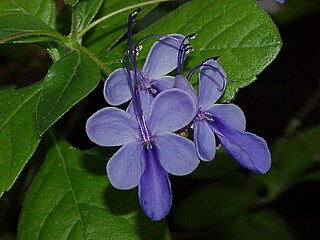
Rotheca is a genus of flowering plants in the family Lamiaceae. Estimates of the number of species in the genus vary from about 35 to as many as 60. Three of the species are native to tropical Asia, with the rest occurring in Sub-Saharan Africa. The type species for the genus is Rotheca serrata. It had originally been named Rotheca ternifolia, but this name is now considered illegitimate.

Johan Theodor Holmskiold was a Danish noble, botanist, courtier and administrator. He was noted for his scientific work with fungi and development of the Charlottenborg Botanical Garden. His career included work as director of the Danish Postal Services and the Royal Porcelain Factory.

Clerodendrum speciosissimum is a tropical shrub of the family Lamiaceae, native to Indonesia and Papuasia, but now naturalized in parts of Latin America, Africa, the Caribbean, Seychelles, and Florida.

Tagetes subulata is an herbaceous plant of the family Asteraceae. It is widespread across most of Mexico, and found also in Central America, Colombia, and Venezuela. It has highly divided bright green leaves and yellow flowers contained in an elongated calyx.
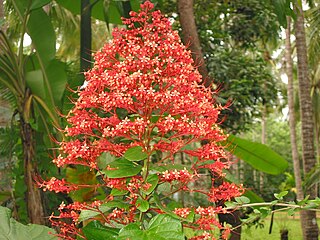
Clerodendrum paniculatum, the pagoda flower, is a species of flowering plant in the genus Clerodendrum and family Lamiaceae. It is native to tropical Asia and Papuasia, Fiji, and French Polynesia. It is introduced in Central America.

Karomia speciosa is an African deciduous large shrub or bushy tree up to 7 m, and relocated to the family Lamiaceae from Verbenaceae. It is one of 9 species in the genus Karomia, a genus containing species previously classified in Holmskioldia, and is closely related to Clerodendrum. The only remaining species in the genus is Holmskioldia sanguinea, occurring in the foothills of the Himalayas.
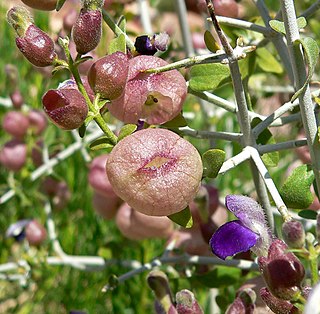
Scutellaria mexicana, commonly known by variants on bladder sage or paperbag bush, is a shrub of the mint family Lamiaceae distinctive for its calyx lobes that develop into small bag- or bladder-like shells around the fruits.
Diastatea is a genus of plants native to Latin America, mostly in Mexico and Central America but with one species extending southward along the Andes to Argentina.
- Diastatea costaricensisMcVaugh - Guatemala, Honduras, Nicaragua, Costa Rica
- Diastatea expansaMcVaugh - central Mexico
- Diastatea ghiesbreghtii(Kuntze) E.Wimm - southwestern Mexico
- Diastatea micrantha(Kunth) McVaugh - widespread from central Mexico to the Jujuy region of northern Argentina
- Diastatea tenera(A.Gray) McVaugh - southern Mexico and Guatemala
- Diastatea virgataScheidw. - southern Mexico
Nietneria is a genus of plants in the Nartheciaceae. It has two known species, both native to northern South America.
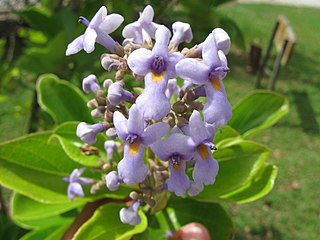
Cornutia is a genus of plants in the family Lamiaceae, first described in 1753. Species in this genus are native to tropical parts of the Western Hemisphere, including southern Mexico, Central America, the West Indies, and northern South America.

Karomia is a genus of plants in the family Lamiaceae. The genus was introduced in 1932 by the botanist Paul Louis Amans Dop (1876–1954) in "Bulletin du Muséum national d'histoire naturelle" (Paris) ser. 2. 4: 1052, for the single species Karomia fragrans. It is native to eastern and southern Africa, Madagascar, and Vietnam.
- Karomia fragransDop – Vietnam
- Karomia gigas(Faden) Verdc. – Kenya, Tanzania
- Karomia humbertii(Moldenke) R.Fern. – Madagascar
- Karomia macrocalyx(Baker) R.Fern. – Madagascar
- Karomia madagascariensis(Moldenke) R.Fern. – Madagascar
- Karomia microphylla(Moldenke) R.Fern. – Madagascar
- Karomia mira(Moldenke) R.Fern. – Madagascar
- Karomia speciosa(Hutch. & Corbishley) R.Fern. – Mozambique, Eswatini, South Africa
- Karomia tettensis(Klotzsch) R.Fern. – Mozambique, Malawi, Zimbabwe, Zambia
Hyptidendron is a genus of plants in the family Lamiaceae, first described in 1849. The entire genus is endemic to South America.
- Hyptidendron amethystoides(Benth.) Harley - eastern Brazil
- Hyptidendron arboreum(Benth.) Harley - Guyana, Venezuela, Colombia, Ecuador, Peru, northwestern Brazil
- Hyptidendron arbusculum(Epling) Harley - Brazil
- Hyptidendron asperrimum(Spreng.) Harley - eastern Brazil
- Hyptidendron canum(Pohl ex Benth.) Harley - Brazil, Bolivia
- Hyptidendron caudatum(Epling & Játiva) Harley - Brazil
- Hyptidendron claussenii(Benth.) Harley - Minas Gerais
- Hyptidendron conspersum(Benth.) Harley - Bahia
- Hyptidendron dictiocalyx(Benth.) Harley - Goiás
- Hyptidendron eximium(Epling) Harley & J.F.B.Pastore - Mato Grosso
- Hyptidendron glutinosum(Benth.) Harley - Brazil, Bolivia
- Hyptidendron leucophyllum(Pohl ex Benth.) Harley - southern Brazil
- Hyptidendron rhabdocalyx(Mart. ex Benth.) Harley - southern Brazil
- Hyptidendron rondonicum(Harley) Harley - Brazil
- Hyptidendron unilaterale(Epling) Harley - southern Brazil
- Hyptidendron vauthieri(Briq.) Harley - southern Brazil
- Hyptidendron vepretorum(Mart. ex Benth.) Harley - Minas Gerais

Apteria is a genus of flowering plants in the Burmanniaceae, first described as a genus in 1834. It contains only one known species, Apteria aphylla, the nodding-nixie, native to the southern United States, Mexico, Central America, the West Indies, and South America.

Chromolaena ivifolia called ivy-leaf false thoroughwort, or ivyleaf thoroughwort, is a species of flowering shrub in the family Asteraceae. It is native to North America and South America, from the south-eastern United States to Argentina.

Koanophyllon villosum, the Florida Keys thoroughwort, or abre camino, is a species of flowering plant in the family Asteraceae. It grows in southern Florida, Cuba, the Bahamas, Hispaniola, Jamaica, and the Islas de la Bahía.





















